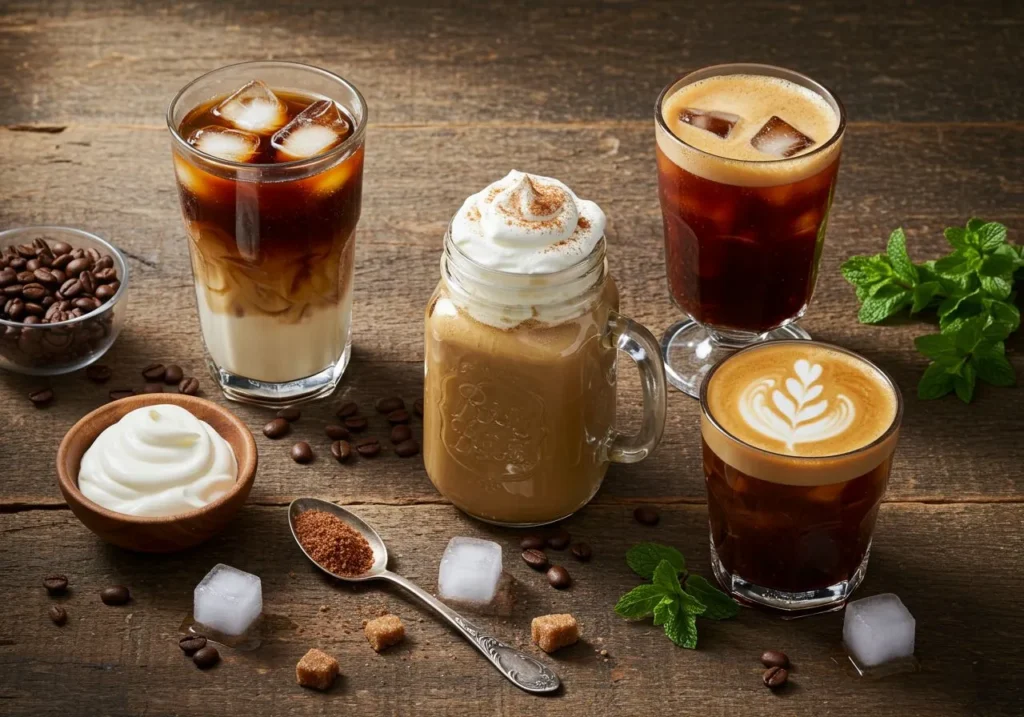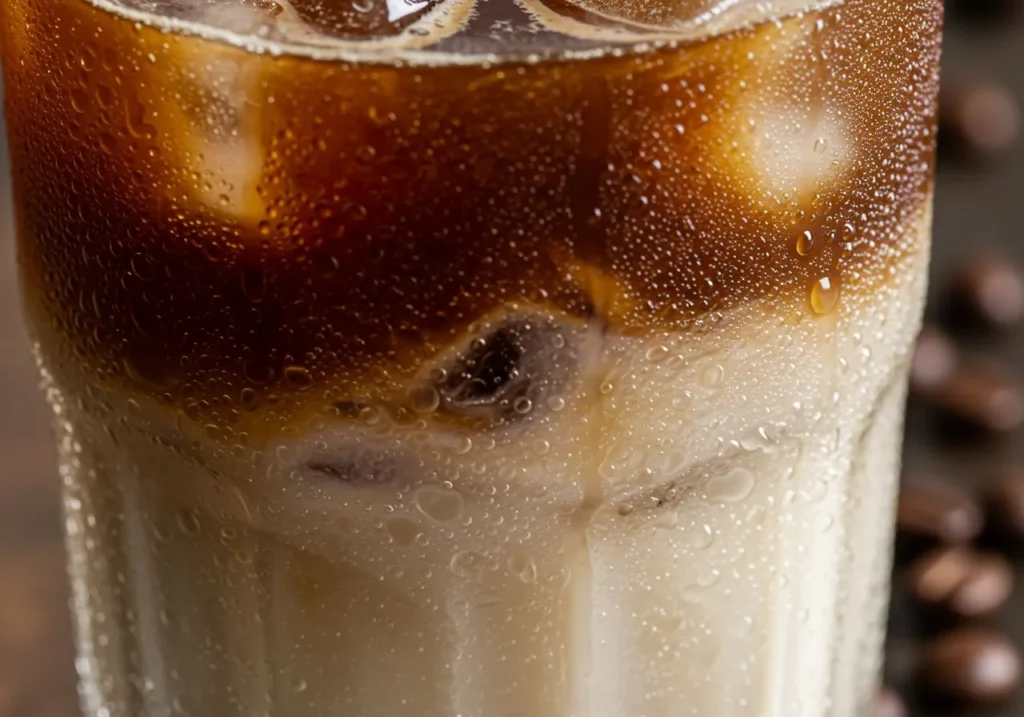
Table of Contents
Introduction
There’s nothing quite like the first sip of a perfectly crafted iced coffee on a sweltering summer morning. I still remember that transformative moment five years ago when I was rushing through the crowded streets of downtown, desperately seeking refuge from the oppressive heat. I ducked into a small café and ordered what would become my obsession – a meticulously crafted cold brew that changed everything I thought I knew about coffee recipes. The barista’s passion for the craft was evident in every detail, from the slow-drip method to the perfect ice-to-coffee ratio that created a drink so refreshing and energizing that it became my daily ritual.
That experience ignited my journey into mastering the art of coffee recipes, particularly the refreshing world of iced variations. Over the years, I’ve experimented with countless brewing methods, flavor combinations, and presentation styles, transforming my kitchen into a personal café laboratory. These coffee recipes have become some of my most treasured family favorite recipes, bringing together friends and loved ones over shared appreciation for perfectly crafted beverages.
What makes these particular iced coffee recipes so special is their versatility and the way they adapt to different tastes, seasons, and energy needs. Whether you’re seeking a quick morning boost, an afternoon pick-me-up, or a sophisticated evening treat, these delicious dishes in liquid form deliver consistent satisfaction. These easy homemade recipes have saved me countless dollars on café visits while allowing me to customize every element to perfection.
The beauty of mastering iced coffee recipes lies not just in the final product, but in understanding how each component contributes to the overall experience. From the quality of your beans to the temperature of your water, every detail matters in creating that perfect balance of flavor, refreshment, and energizing power that transforms an ordinary moment into something extraordinary.

Refreshing Iced Coffee Recipes to Keep You Energized
Master the art of creating refreshing iced coffee recipes at home with professional techniques, quality ingredients, and creative presentation ideas for café-quality results.
Ingredients
Instructions
- 1If using hot coffee, allow it to cool to room temperature. For cold brew, prepare concentrate according to package directions or make fresh using 1:4 coffee to water ratio.
- 2In your serving glass, add simple syrup or preferred sweetener to taste. This mixes more easily when added first.
- 3Pour the cooled coffee or cold brew concentrate into the glass, leaving room for milk and ice.
- 4Slowly pour milk over the back of a spoon to create layers if desired, then add ice cubes to fill the glass.
- 5Top with whipped cream if using, dust with cinnamon or cocoa powder, and serve immediately with a straw.
Essential Ingredients for Perfect Iced Coffee Recipes
Understanding Your Coffee Foundation and Flavor Builders
The cornerstone of any exceptional iced coffee recipes begins with understanding your coffee beans and their unique characteristics. High-quality, freshly roasted beans form the foundation of every great cup, but for iced preparations, medium to dark roasts typically work best because they maintain their flavor integrity when diluted with ice and additional ingredients. The roasting process creates compounds that hold up beautifully to cold preparation methods, ensuring your coffee recipes deliver consistent flavor even as temperatures drop.
Cold brew concentrate serves as the ultimate base for versatile iced coffee recipes, providing a smooth, less acidic foundation that accepts flavor additions beautifully. The slow extraction process – typically 12 to 24 hours – creates a concentrated coffee essence that’s naturally sweeter and more mellow than traditional hot-brewed coffee. This concentrate can be stored for up to two weeks, making it perfect for batch preparation of your favorite coffee recipes.
Espresso shots offer another excellent foundation, particularly for those who prefer more intense, immediate gratification in their coffee recipes. The concentrated nature of espresso creates bold flavors that shine through ice and milk, while the crema adds textural interest to finished drinks. For home preparation, a quality espresso machine or moka pot can produce the strong coffee base needed for authentic café-style iced coffee recipes.
Selecting Premium Ingredients for Maximum Impact
Quality ingredients make the difference between amateur and professional-level iced coffee recipes. When selecting coffee beans, look for roast dates within two to four weeks of purchase, as freshness directly impacts flavor development in cold preparations. Single-origin beans often provide more complex flavor profiles that shine in simple iced coffee recipes, while blends offer consistency and balanced flavor that works well with added ingredients.
Water quality significantly impacts your final results, though it’s often overlooked in coffee recipes. Filtered water removes chlorine and other chemicals that can interfere with extraction, while maintaining beneficial minerals that enhance flavor development. The ideal water temperature for hot brewing (which you’ll cool for iced preparations) ranges between 195-205°F, allowing optimal extraction without burning delicate flavor compounds.
Milk and cream selections dramatically influence the texture and richness of your iced coffee recipes. Whole milk provides the creamiest texture and richest flavor, while oat milk offers natural sweetness and excellent frothing properties. Heavy cream creates luxurious texture but can overwhelm delicate coffee flavors, making it better suited to robust, dark-roasted bases in your coffee recipes.
Creative Substitutions and Dietary Adaptations
Modern iced coffee recipes can accommodate virtually any dietary preference or restriction without sacrificing flavor or satisfaction. Plant-based milk alternatives each bring unique characteristics to coffee recipes – almond milk adds subtle nuttiness, coconut milk contributes tropical richness, and soy milk provides protein and creamy texture similar to dairy milk.

For those avoiding traditional sweeteners, natural alternatives can enhance your coffee recipes without overwhelming the coffee’s inherent flavors. Maple syrup adds complexity with its subtle caramel notes, while agave nectar dissolves easily in cold liquids and provides clean sweetness. Date syrup offers rich, molasses-like sweetness that pairs beautifully with darker roasted beans in sophisticated coffee recipes.
Sugar-free options for coffee recipes have evolved significantly, with monk fruit sweetener and stevia providing intense sweetness without aftertaste when used properly. Erythritol dissolves well in cold liquids and measures cup-for-cup like sugar, making it ideal for batch preparation of your favorite iced coffee recipes. The key is experimenting with ratios to find your perfect balance in these adaptable coffee recipes.
Mastering the Art of Preparation
Foundation Techniques and Equipment Setup
Creating exceptional iced coffee recipes begins with proper equipment setup and understanding fundamental brewing principles. A quality grinder represents the most important investment for serious coffee recipes, as freshly ground beans provide significantly better flavor extraction than pre-ground alternatives. Burr grinders offer consistent particle size, crucial for even extraction in all types of coffee recipes.
Cold brew preparation requires patience but rewards you with incredibly smooth results perfect for multiple iced coffee recipes. Use a coarse grind – similar to French press consistency – and maintain a 1:4 ratio of coffee to water for concentrate, or 1:8 for ready-to-drink strength. The steeping process should occur at room temperature or in the refrigerator, with longer steeping times producing stronger concentrates for your coffee recipes.
For hot-brew methods that you’ll ice later, the Japanese iced coffee technique produces exceptional results in your coffee recipes. This method involves brewing hot coffee directly over ice, rapidly cooling the coffee while preserving bright, acidic flavors that might be lost in cold brew methods. The key is calculating your ice weight into your total water measurement to maintain proper extraction ratios in these precision-focused coffee recipes.
Step-by-Step Construction with Professional Secrets
The secret to café-quality iced coffee recipes lies in layering flavors and temperatures strategically. Begin by preparing your coffee base – whether cold brew concentrate, fresh espresso, or hot-brewed coffee – and allowing it to reach the appropriate temperature. Cold bases can be used immediately, while hot bases need cooling time to prevent melting ice too rapidly in your finished coffee recipes.
Ice quality and preparation significantly impact the final results of your coffee recipes. Large, dense ice cubes melt slowly and provide better temperature control, while crushed ice creates rapid cooling but dilutes flavors quickly. Coffee ice cubes – frozen coffee that won’t dilute your drink as it melts – represent a game-changing technique for maintaining flavor integrity in your most precious coffee recipes.
The assembly order matters tremendously in layered iced coffee recipes. Start with syrups or sweeteners in the bottom of your glass, as they mix more easily with the first liquid added. Add your coffee base next, followed by milk or cream, which can be poured slowly over a spoon to create beautiful layering effects in presentation-focused coffee recipes. Top with ice last to maintain temperature without premature dilution.
Avoiding Common Mistakes and Kitchen Disasters
The most frequent error in iced coffee recipes is using coffee that’s too weak to stand up to ice dilution. Coffee that tastes perfect hot will taste watery and disappointing once ice is added, so always brew stronger than you think necessary for iced preparations. This principle applies to all varieties of coffee recipes and separates amateur from professional results.
Temperature shock represents another common pitfall in coffee recipes. Adding hot coffee directly to ice creates rapid melting and immediate dilution, destroying the careful balance you’ve worked to achieve. Allow hot-brewed coffee to cool to room temperature, or use the Japanese iced coffee method with calculated ice ratios to maintain proper strength in your coffee recipes.
Over-extraction ruins many promising iced coffee recipes, creating bitter, harsh flavors that no amount of sweetener or milk can rescue. This typically occurs when using fine grinds with long steeping times, or when brewing water is too hot. Understanding your specific brewing method’s requirements prevents this common mistake and ensures consistently delicious results in all your coffee recipes.
Presentation, Pairing, and Perfect Enjoyment
Creative Presentation Ideas That Impress
Presentation transforms simple iced coffee recipes into Instagram-worthy creations that impress guests and elevate your daily routine. Glassware selection impacts both visual appeal and drinking experience – tall, clear glasses showcase layered coffee recipes beautifully, while wide-mouth mason jars provide rustic charm perfect for casual settings. The vessel becomes part of the overall experience in thoughtfully presented coffee recipes.
Garnish possibilities for iced coffee recipes are virtually limitless, from classic whipped cream swirls to sophisticated chocolate shavings or cinnamon dust. Fresh mint sprigs add aromatic appeal and cooling sensation, while orange or lemon zest provides bright citrus notes that complement coffee’s natural acidity. These finishing touches transform ordinary coffee recipes into memorable experiences.
Layering techniques create visual drama in your coffee recipes while maintaining distinct flavor profiles. Dense syrups settle to the bottom, coffee forms the middle layer, and lighter milk or cream floats on top, creating beautiful gradients that slowly blend as you drink. Mastering these techniques elevates your coffee recipes from simple beverages to artistic expressions.
Perfect Pairings and Complementary Treats
Iced coffee recipes pair wonderfully with both sweet and savory accompaniments, making them versatile additions to any meal or snack time. For breakfast, these coffee recipes complement pastries, fresh fruit, or granola parfaits beautifully. The caffeine provides energy while the cold temperature offers refreshing contrast to warm breakfast items.
Afternoon pairings for iced coffee recipes include light sandwiches, salads, or cheese plates that won’t compete with the coffee’s complex flavors. The cooling effect of these coffee recipes makes them ideal companions to spicy foods, providing palate relief while maintaining energy levels throughout the day.

Evening presentations of iced coffee recipes can incorporate dessert elements like ice cream, chocolate sauce, or liqueurs for adults. These sophisticated variations transform your basic coffee recipes into elegant after-dinner drinks that satisfy both caffeine cravings and sweet tooth desires.
Storage Solutions and Make-Ahead Strategies
Proper storage extends the life and maintains the quality of your prepared iced coffee recipes components. Cold brew concentrate stores beautifully in the refrigerator for up to two weeks, providing the foundation for multiple coffee recipes throughout that period. Store in airtight glass containers to prevent flavor absorption and maintain optimal taste in your coffee recipes.
Pre-made flavor syrups and coffee ice cubes can be prepared in batches, streamlining the assembly process for your favorite coffee recipes. Ice cube trays filled with sweetened coffee create flavorful additions that enhance rather than dilute your drinks. These preparation techniques make it easy to enjoy café-quality coffee recipes even during busy mornings.
Individual serving preparations work well for meal prep enthusiasts who want convenient access to their favorite coffee recipes. Layer dry ingredients and syrups in mason jars, add coffee concentrate and milk just before serving. This approach maintains freshness while providing grab-and-go convenience for your beloved coffee recipes.
 DINNER
DINNER LUNCH
LUNCH CAKE
CAKE BREAKFAST
BREAKFASTFor more amazing recipes, be sure to check out our other sections to explore a variety of ideas that will enrich your cooking experience. Each section offers its own unique flavors to ensure a delightful culinary journey:
- Easy and Quick Recipes: A collection of dishes that guarantee delicious meals with minimal effort and time.
- Healthy Recipes: Discover healthy and delicious options that fit your lifestyle.
- Desserts: A diverse selection of sweets that will add a special touch of sweetness to your table.
- Lunch Recipes: Tasty lunch ideas that you can easily prepare to delight your family.
- Dinner Recipes: Delicious and easy-to-make recipes that will make your dinner a memorable occasion.
Frequently Asked Questions
How do I make my iced coffee recipes as strong as café versions?
The key is brewing coffee stronger than you would for hot consumption, as ice dilution will weaken the final product. Use a 1:15 coffee-to-water ratio for hot brew methods, or create cold brew concentrate at 1:4 ratio. Additionally, consider using coffee ice cubes instead of regular ice to prevent dilution while maintaining temperature in your coffee recipes.
What’s the difference between cold brew and iced coffee in terms of coffee recipes?
Cold brew uses room temperature or cold water with extended steeping time (12-24 hours), creating smooth, less acidic coffee recipes. Iced coffee typically involves hot brewing methods cooled with ice, preserving more acidic brightness and complex flavors. Both methods work excellently in different coffee recipes depending on your flavor preferences
Can I prepare these coffee recipes ahead of time for busy mornings?
Absolutely! Cold brew concentrate can be made up to two weeks ahead, and many components can be prepped in advance. Store coffee concentrate, simple syrups, and even coffee ice cubes separately, then combine when ready to serve. Avoid adding dairy products until serving time to maintain freshness in your coffee recipes.
Why do my homemade coffee recipes taste different from café versions?
Several factors influence taste: coffee bean quality and freshness, water quality, grind consistency, and brewing ratios. Cafés often use commercial-grade equipment and specific ratios perfected for their coffee recipes. Focus on using freshly roasted beans, filtered water, and consistent measurements to improve your homemade coffee recipes.
What milk alternatives work best in iced coffee recipes?
Oat milk froths beautifully and adds natural sweetness, making it excellent for creamy coffee recipes. Almond milk works well but can separate in acidic coffee. Coconut milk provides richness, while soy milk offers protein and creamy texture similar to dairy. Experiment with different alternatives to find your preferred taste and texture in coffee recipes.
Conclusion
Mastering the art of iced coffee recipes has transformed not just my daily routine, but my entire relationship with this beloved beverage. These coffee recipes represent more than just drinks – they’re moments of personal indulgence, creative expression, and refreshing energy that fuel both body and spirit. The journey from that first transformative sip in a downtown café to creating café-quality coffee recipes in my own kitchen has been filled with experimentation, discovery, and countless perfect moments.
The beauty of these iced coffee recipes lies in their adaptability to your personal taste preferences, dietary needs, and lifestyle demands. Whether you’re seeking a quick morning energizer, a sophisticated afternoon treat, or a creative canvas for flavor experimentation, these coffee recipes provide the foundation for endless possibilities. Each recipe becomes a personal signature, reflecting your unique taste and style.
I encourage you to embrace the experimental spirit that makes coffee recipes so rewarding. Start with the basic techniques outlined here, then let your creativity guide you toward unique flavor combinations and presentation styles that make these coffee recipes uniquely yours. Don’t be afraid to adjust ratios, try new ingredients, or develop entirely new variations that suit your preferences.
Share your creations and discoveries with friends and family – some of my most treasured memories involve introducing others to new coffee recipes and watching their faces light up with that first perfect sip. These easy homemade recipes have the power to bring people together, create new traditions, and transform ordinary moments into something special.
Most importantly, remember that the best coffee recipes are the ones you actually enjoy making and drinking. Trust your palate, enjoy the process, and let these coffee recipes become part of your daily ritual of self-care and energizing refreshment.
